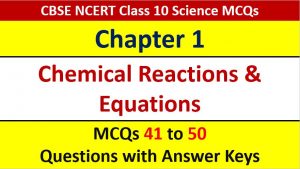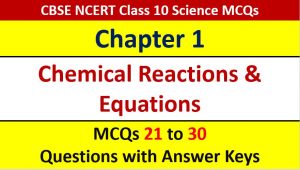If you are preparing for CBSE Class 12 Board Exam Term 1 which will be an objective type questions paper, then you need to practice multiple choice questions of Class 12 Chemistry Chapterwise. In this article of AKVTutorials, you will get MCQ Questions for Class 12 Chapter 4 Chemical Kinetics with Answer Keys.
MCQ Questions for Class 12 Chemistry Chapter 4 Question No 1:
If the concentration is expressed in molL-1 and time in s, then the units of the rate constant for the first order reaction is
Option A : molL-1s-1
Option B : mol-1Ls-1
Option C : s-1
Option D : mol2L-2s-1
Show/Hide Answer
Option C : s-1
MCQ Questions for Class 12 Chemistry Chapter 4 Question No 2:
Half life period of any first order reaction is
Option A : directly proportional to the initial concentration of the reactant
Option B : half life of the rate constant
Option C : same for all reactions
Option D : independent of initial concentration of reactants
Show/Hide Answer
Option D : independent of initial concentration of reactants
MCQ Questions for Class 12 Chemistry Chapter 4 Question No 3:
The rate law for the chemical reactions:
2NO2Cl → 2NO2 + Cl2 Is
Rate=k[NO2Cl]
The determining step is
Option A : 2NO2Cl → 2NO2 + Cl2
Option B : NO2 + Cl2 → NO2Cl + Cl
Option C : NO2Cl + Cl → NO2 + Cl2
Option D : NO2Cl → NO2 + Cl
Show/Hide Answer
Option D : NO2Cl → NO2 + Cl
MCQ Questions for Class 12 Chemistry Chapter 4 Question No 4:
The rate constant of the reaction is 1.2 X 10-5 mol-2L2s-1. The order of the reaction is
Option A : Zero
Option B : 1
Option C : 2
Option D : 3
Show/Hide Answer
Option D : 3
MCQ Questions for Class 12 Chemistry Chapter 4 Question No 5:
For the reaction
2N2O5 → 4NO2+ O2 rate and rate constant are 1.22 X 10-4 and 3.4 X 10-5 s-1 respectively, then the concentration of N2O5 at that time will be:
Option A : 1.732
Option B : 3.6
Option C : 1.02 X 10-4
Option D : 3.4 X 105
Show/Hide Answer
Option B : 3.6
MCQ Questions for Class 12 Chemistry Chapter 4 Question No 6:
For zero order reaction, linear plot was obtained for [A] vs t. The slope of the line is equal to :
Option A : k0
Option B : -k0
Option C : 0.693/k0
Option D : -k0/2.303
Show/Hide Answer
Option B : -k0
MCQ Questions for Class 12 Chemistry Chapter 4 Question No 7:
For a reaction having rate law expression:
Rate = k[A]3/2[B]-1/2
If the concentration of both A and B becomes four times, The rate of reaction
Option A : becomes four times
Option B : becomes 16 times
Option C : decreases four times
Option D : remains same
Show/Hide Answer
Option A : becomes four times
MCQ Questions for Class 12 Chemistry Chapter 4 Question No 8:
In the presence of catalyst, the heat evolved or absorbed during the reaction ________.
Option A : increases
Option B : decreases
Option C : remains unchanged
Option D : may increase or decrease
Show/Hide Answer
Option C : remains unchanged
MCQ Questions for Class 12 Chemistry Chapter 4 Question No 9:
Consider a first order gas phase decomposition reaction given below:
A(g) → B(g) + C(g)
The initial pressure of the system before decomposition of A was pi. After lapse of time ‘t’, total pressure of the system increased by x units and became ‘pt‘. The rate constant k for the given reaction is given as ____.
Option A : k = (2.303/t)log (pi/pi-x)
Option B : k = (2.303/t)log (pi/2pi–pt)
Option C : k = (2.303/t)log (pi/2pi+pt)
Option D : k = (2.303/t)log (pi/pi+x)
Show/Hide Answer
Option B : k = (2.303/t)log (pi/2pi-pt)
MCQ Questions for Class 12 Chemistry Chapter 4 Question No 10:
Which of the following is not correct about order of a reaction
Option A : The order of a reaction can be fractional number.
Option B : Order of a reaction is experimentally determined quantity
Option C : The order of a reaction is always equal to the sum of the stoichiometric coefficients of reactants in the balanced chemical equation for a reaction
Option D : The order of a reaction is the sum if the powers of molar concentration of the reactants in the rate law expression
Show/Hide Answer
Option C : The order of a reaction is always equal to the sum of the stoichiometric coefficients of reactants in the balanced chemical equation for a reaction


